Last Updated on January 7, 2024 by Matt Greene
Golf club lofts are what determines how far the golf ball travels, how high it flies and how much spin it has. Each club is designed with a specific purpose and the club head design is matched to the loft to make that specific club do what it should.
In this guide, we will look at every golf club you could have in your bag to analyze the loft angles of each club. We'll take a look at the golf club lofts of drivers, fairway woods, hybrids, irons, wedges and even putters. Yes putters have a tiny bit of loft and are not flat!
Golf Club Lofts Chart - Compare golf club lofts
This chart is a quick summary of every available club you could choose to play in your golf bag.
The PGA Tour pros play different lofts to us amateurs and their lofts are often much higher per club. Game improvement irons have some of the lowest lofts in golf. The big manufacturers make a variety of irons sets for different standards of players so your ideal loft could fall in the middle of the two options we've shown.
Listed below in the chart are the lofts for Pro lofts, Standard (Std) lofts, and GI (Game Improvement) lofts:
| Golf Club | Pro Loft | Std Loft | GI Loft |
| Driver | 9° | 10° | 12° |
| 3 wood | 14° | 15° | 16° |
| 5 wood | 17° | 18° | 19° |
| 7 wood | 20° | 21° | 21° |
| 2 hybrid | 16° | 17° | - |
| 3 hybrid | 19° | 19° | 19° |
| 4 hybrid | 22° | 22° | 22° |
| 5 hybrid | 25° | 25° | 25° |
| 2 iron | 18° | 19° | - |
| 3 iron | 21° | 20° | 18° |
| 4 iron | 24° | 22° | 20.5° |
| 5 iron | 27° | 25° | 23° |
| 6 iron | 31° | 28° | 26° |
| 7 iron | 35° | 32° | 30° |
| 8 iron | 39° | 36° | 34.5° |
| 9 iron | 44° | 41° | 39° |
| PW | 48° | 46° | 44° |
| GW | 52° | 50° | 49° |
| SW | 56° | 54° | 54° |
| LW | 60° | 58° | 59° |
| Putter | 3° | 3° | 3° |
Did you notice how the loft goes UP in the woods and DOWN in the irons? That's because the woods are easier to hit with higher lofts while the irons have been produced in a way that makes them go higher than usual, so the manufacturers can reduce the loft enough to make the ball go HIGH and FARTHER!
Driver Loft - 9 to 13 Degrees
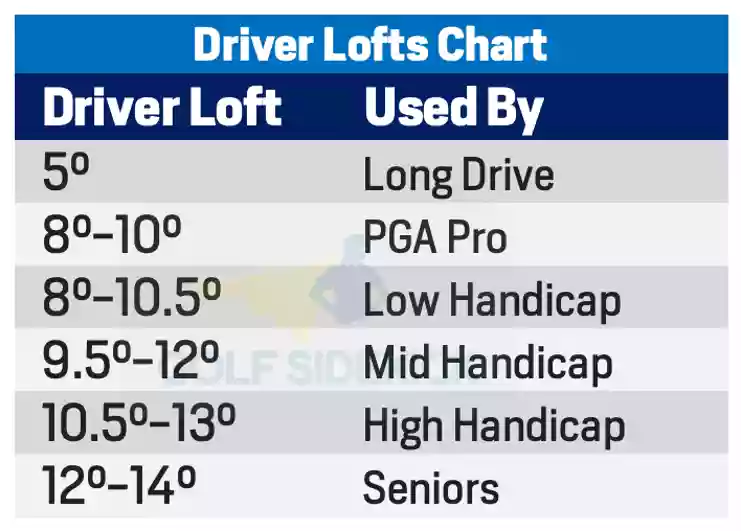
Drivers are the lowest lofted club found in a golf bag and have the longest shaft, with a standard length of around 45 inches. Generally a driver goes the furthest out of all the clubs.
The standard loft angle of drivers is 9 to 13 degrees.
Drivers are usually hit off a golf tee, which places the golf ball off the ground. This allows a golfer to swing a driver with a slightly upward angle, increasing the loft angle of the driver beyond the number printed on the club head.
When selecting the correct driver loft for your game, you need to consider a few things.
If you're a golfer with a slower swing speed or if you hit down on the ball with driver, you may benefit from higher lofted drivers (11-13°) These are sometimes called a "High Launch" option and are often paired with a more flexible golf shaft.
Faster swinging golfers who hit up on the ball with their driver can play a club with less loft, somewhere between 8-10 degrees. This should be paired with a golf ball for your faster swing speed.
Nowadays, driver lofts are adjustable with a tool included in the driver box. You can now be your own club fitter. You can use the tool provided with most modern drivers to adjust the loft of the club up or down by 1-3 degrees.
I would recommend making small adjustments or having the loft angle adjusted by a PGA pro or club fitter to make sure the settings are correct for your swing to maximize your ball flight for more carry distance.
Fairway Wood Lofts
3-Wood Loft - 13.5 to 16 Degrees
The standard 3-wood loft is 15 degrees.
You can also find lower lofted 3 woods with 13.5 - 14.5 degrees of loft which are called "Tour Spoons" or Strong 3 woods.
There are 3 woods that have 16 to 17 degrees of loft, and these are labeled High Launch or HL.
In reality, fairway woods with a loft angle between 16 and 17 degrees is a 4 wood but we don't use that term much.
What 3 wood loft is right for me?
The best 3-wood loft for your golf game will depend on what you're looking to get from a club of this length - 43 inches.
Low handicap players will game a 3 wood with lower loft to maximize tee shot distance and also allow them to hit long approach shots into par 5s. Usually these golfers have faster swing speeds which is needed to elevate a low lofted 3 wood.
High handicappers, players with low swing speed or seniors should play a higher loft 3 wood. The extra loft helps them to get the ball in the air, especially when using the club from the grass.
Many fairway woods now come with adjustable loft so you can tweak the club to suit your game.
4-Wood Loft - 16 to 18 Degrees
17 degrees is the standard 4 wood loft.
4-woods are easier to hit than a 3 wood and is Golf Sidekick's top recommendation for all golfers - get a 4 wood not a 3 wood!
5-Wood Loft - 17 to 19 Degrees
5-Woods have 17-19 degrees of loft.
In recent years, 5 woods were replaced by driving irons or hybrids but they are making a comeback thanks to their popularity with players on the PGA tour.
Rory McIlroy for example will play a 5 wood on courses where he needs to hit high shots which stop quickly on long par 4's and par 5's. He will then switch this club out for a driving iron when conditions are fast and firm, like on links courses.
7-Wood Loft - 21 to 23 Degrees
7-woods have a standard loft of 21 degrees. They replace a 3 iron or 4 iron.
7-woods are becoming more and more popular with golfers of all skill levels.
They are often easier to hit than long irons like the 3 and 4 iron and are very forgiving from a variety of lies.
They offer a much higher ball flight than an iron with the same loft because of the hollow body and center of gravity which is further back in the club. I put one in my bag recently to replace my 2 iron and I love it.
PGA Tour players like Dustin Johnson and Bubba Watson are just a couple of elite who will game a 7 wood in tournaments.
9-Wood Loft - 23.5 to 25 Degrees
Standard loft of a 9 wood is 24 degrees.
The 9 wood is very rare so if you find one, you should hold onto it for dear life!
11-Wood Loft - 26 to 28 Degrees
11-woods have a loft of 27 degrees.
An 11 wood is very rare, but you can probably find a few cheap versions on Amazon or used clubs on eBay. They are very easy to hit and if you struggle to get your 6 or 7 iron airborne, the 11 wood is a great investment. If you find one, take it - because you won't see another for a while!
Fairway wood lofts chart
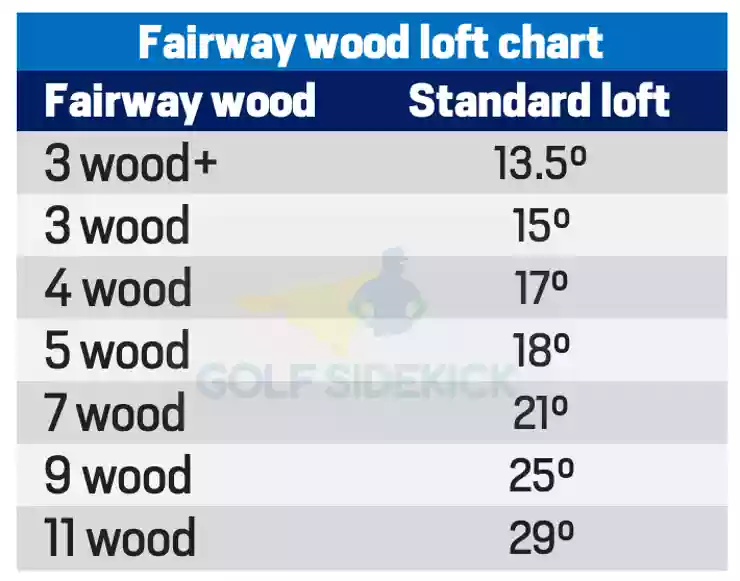
Iron Lofts
In modern times, there is no 'standard' iron loft anymore. In the 70s and 80s, irons had only one loft and the lofts were much higher back then.
You may see people talking about "traditional" lofts which means that the loft of each iron is higher than a modern iron.
Modern irons have so much technology in them that a 7 iron can be as low as 28 degrees of loft. 'Traditional' lofts were more around 38-40 degrees. That can make a 30 yard difference in distance.
Over the years golf club manufacturers have made irons with stronger lofts. Most golfers want more distance so golf club companies have made clubs that fly greater distance by reducing loft, while increasing the height of the shot with that loft!
| Iron | 1980s | 1990s | 2000s | 2020s |
| 1 iron | 17° | NLE* | NLE* | NLE* |
| 2 iron | 20° | 19° | ||
| 3 iron | 24° | 22° | 20° | 18° |
| 4 iron | 28° | 26° | 23° | 21° |
| 5 iron | 32° | 30° | 26° | 24° |
| 6 iron | 36° | 34° | 30° | 28° |
| 7 iron | 40° | 38° | 34° | 32° |
| 8 iron | 44° | 42° | 38° | 36° |
| 9 iron | 48° | 46° | 42° | 40° |
| PW | 52° | 50° | 46° | 45° |
| GW | 50° | 50° | ||
| SW | 56° | 56° | 56° | 55° |
Iron lofts are getting stronger in modern equipment. Many people complain about that and refer to the strong lofts as 'jacked lofts'.
Ignore these people.
There is no disadvantage to what has happened in the golf industry. Yes the lofts are lower, which makes the ball go farther, but the technologies have also helped golfers hit the ball higher with much more ease.
While there is nothing wrong with the loft reductions, it is good for average golfers to understand the irons set in their hand might be a completely different loft to the one that Tiger Woods or Phil Mickelson are using. They may be different to your friends, so don't feel bad if you don't hit the ball as far with the same number stamped on your club.
Middle irons like seven irons are usually around 27 degrees.
High-lofted irons such as a 9-irons are commonly played at a loft of around 41 degrees.
1 irons are now obsolete and no one produces them anymore. A 2 iron is now rarely sold in iron sets to average golfers as they are just too difficult to hit. They have been replaced by a lofted fairway wood and hybrids which have changed the game for high handicappers.
1-Iron Loft - 14 to 16 Degrees
1-irons usually have lofts between 14 to 16 degrees.
1 irons are a relic of a past golfing era. They are nearly impossible to hit unless you're a golfing god like Jack Nicklaus or Ben Hogan or Golf Sidekick.
2-Iron Loft - 16 to 19 Degrees
Modern 2-irons have between 16 to 19 degrees of loft which change depending on the golf club manufacturer's design.
2 irons haven't completely disappeared from golf, as many manufacturers now make easier to hit driving irons. You do need to purchase them separate to your iron set.
3-Iron Loft - 19 to 21 Degrees
3 irons have lofts ranging from 19 to 21 degrees.
I added a 3 iron to my bag recently to replace my 2 iron. It's easier for me to hit from the fairway but most players would be better served using a hybrid or fairway wood.
4-Iron Loft - 21 to 24 Degrees
A standard 4-iron loft is between 21 to 24 degrees of loft, however, game improvement 4-irons will have lofts as low as 19 degrees.
When I got my first set of irons fitted, a 4 iron was standard. Now because lofts are decreasing as standard, many sets won't include a 4 iron. It will be replaced by a hybrid or fairway wood.
5-Iron Loft - 25 to 27 Degrees
A traditional 5-iron loft is between 25 to 27 degrees. Game improvement irons can have 5-irons with as low as 21 degrees of loft.
You would expect to see a 5 iron in nearly every golf bag.
6-Iron Loft - 24 to 31 Degrees
Traditionally lofted 6 irons have lofts from 30 to 31 degrees. 6-irons made for high handicappers can have as little loft as 24 degrees.
7-Iron Loft - 28 to 35 Degrees
The standard loft for a 7-iron is 34 to 35 degrees. Lower lofted game improvement 7-iron lofts play at 28 degrees or less.
8-Iron Loft - 32 to 39 Degrees
Typical 8-iron lofts are 37 to 39 degrees. Catering to higher handicappers, the super game improvement irons have lofts down at 32 degrees.
9-Iron Loft - 37 to 43 Degrees
The standard loft for 9-irons is 41 to 43 degrees, while game improvement 9-iron lofts often go as low as 37 degrees.
Wedge Lofts
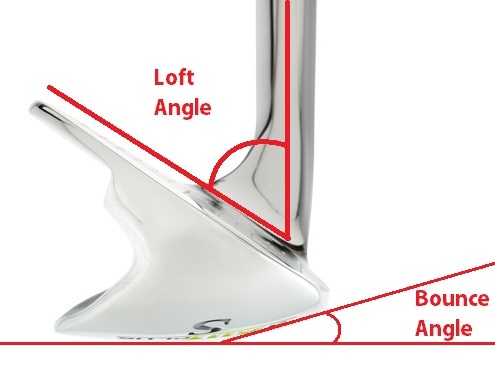
Here's what I play:
Pitching wedge - 45 degrees
Gap wedge - 48 degrees
Sand wedge - 56 degrees
Lob wedge - 60 degrees
Sand and lob wedges are specialist short game clubs used for chip shots around the greens and for playing out of bunkers. The vast majority of these wedges are bought separately to a set of irons and many golfers will have a specific head shape, bounce and sole grind that they prefer for their wedges.
Pitching Wedge (PW) Loft - 43 to 47 Degrees
Standard pitching wedges (PW) have 45 to 47 degrees of loft.
In a game improvement set of clubs, the pitching wedge will have a lower loft, around 43 or even 42 degrees.
Gap Wedge (GW)/Approach Wedge (AW) Loft - 48 to 52 Degrees
A gap wedge or approach wedge, has a typical loft of 51 to 52 degrees.
A gap wedge is designed to fill the loft gap between your pitching wedge and sand wedge.
Usually golfers have a pitching wedge and a sand wedge from their golf sets. There is often a 10-12 degree loft difference so many golfers find that a gap wedge or approach wedge can slot in between the two lofts.
Sand Wedge (SW) Loft - 54 to 58 Degrees
The most common loft for a sand wedge is 56 degrees.
Sand wedges are the most versatile chipping clubs for amateur golfers which can be used in the sand or from the rough and fairways to get the ball onto the green.
Lob Wedge (LW) Loft - 58 to 60 Degrees
A classic lob wedge is 60 degrees.
I recommend that most golfers avoid using a club with more than 58 degrees of loft. Yes, advanced players will be seen playing flop shots from impossible lies, but without a lot of practice, these shots are more dangerous than just chipping with your trusty sand iron.
Hybrid Lofts
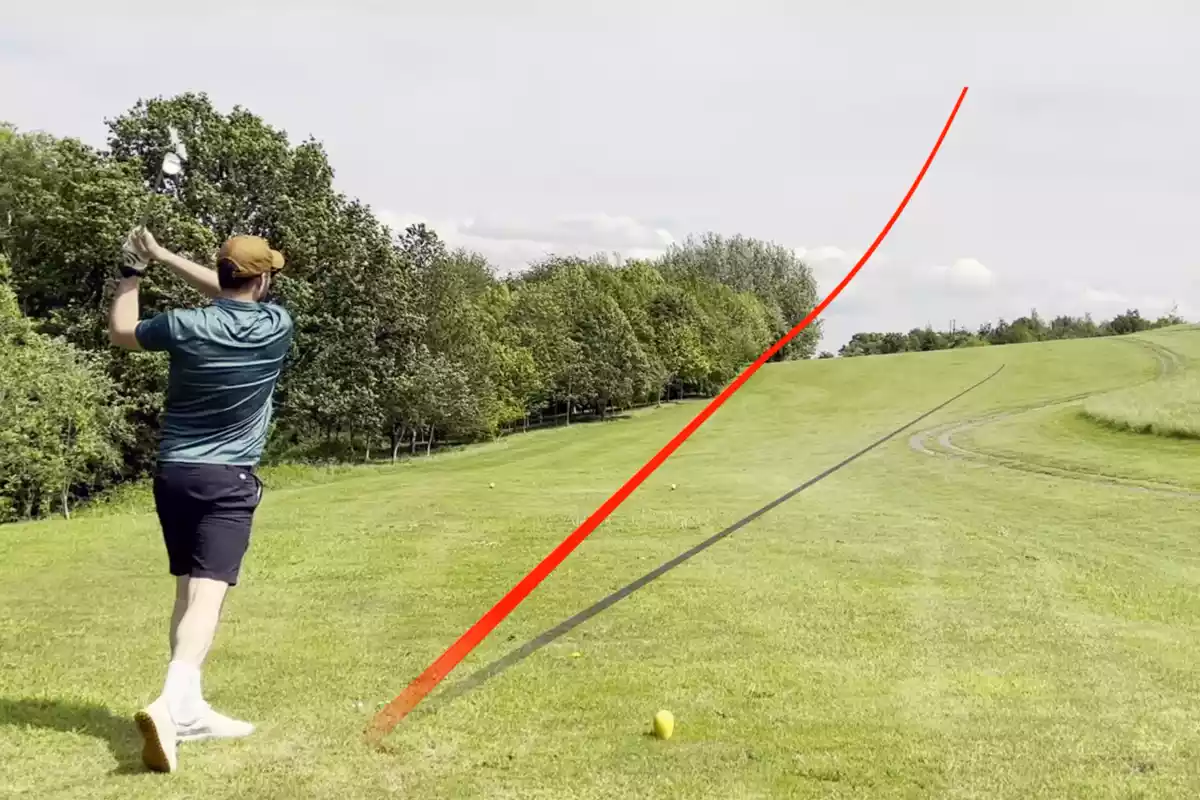
Hybrid golf clubs have become popular in the last 10 years as replacements for long irons.
Hybrid lofts usually fit within the loft range of the same numbered irons so a 4 hybrid has similar loft to a 4 iron.
A Hybrid may have the same loft as its iron counterpart, but hybrids are typically more forgiving, higher launching, and descend onto the ground at a steeper angle to stop quickly. They my also carry further than irons at lower swing speeds.
3-Hybrid Loft (3H) - 19 to 20 Degrees
3-Hybrids usually have 19 to 20 degrees of loft.
This puts 3-hybrids in the same range as standard lofted 3-irons and super game improvement 4-irons.
4-Hybrid Loft (4H) - 21 Degrees Hybrid
4 hybrids have 21 to 23 degrees of loft.
This means 4-hybrids usually have slightly lower loft than 4-irons when they are made for the best golfers. For beginners or high handicappers, 4-hybrids usually have lofts more similar to 4-irons.
5-Hybrid Loft (5H) - 24 to 26 Degrees
The majority of 5-hybrids have between 24 to 26 degrees of loft.
5-hybrids usually have lofts similar to 5-irons made for the best players, while being noticeably more lofted than game improvement 5-irons.
For example, the game improvement style TaylorMade SIM2 max 5-iron has just 21.5 degrees, while the SIM2Max 5-hybrid has 25 degrees.
Other Hybrid Lofts
A 2-Hybrid has 17 to 18 degrees of loft. There are not many manufacturers who focus on 2 hybrids but Taylormade are famous for their 2 hybrids.
Hybrids with more loft than a 5 hybrid are usually only used by beginners and those with very slow swing speeds. Many manufacturers don't even make hybrids higher than 5.
A 6-hybrid has around 27 to 28 degrees of loft.
A 7-hybrid usually has around 31 degrees of loft.
Driving iron loft
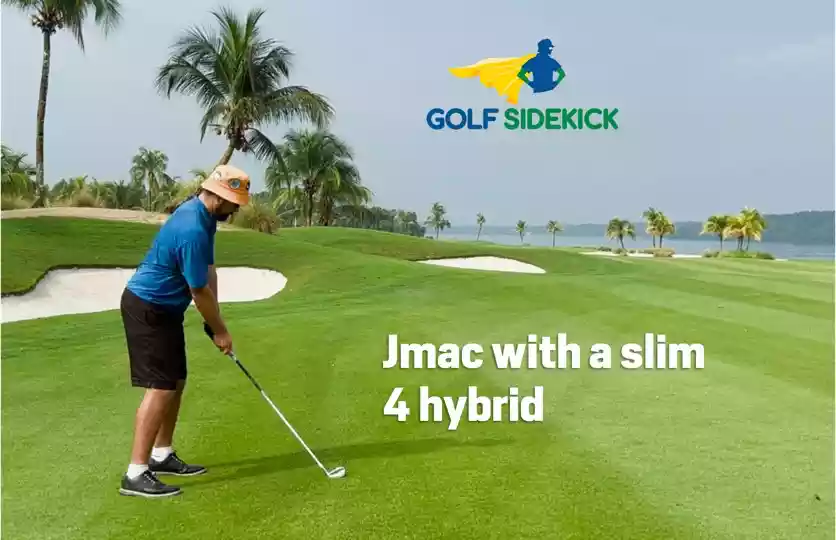
Driving irons usually have lofts from 18-23 degrees to match a modern 2 iron to 5 iron.
Driving irons like the Srixon U85, Mizuno FLiHi and Takomo 101 come in 2 iron, 3 iron and 4 iron varieties.
Some players struggle with hooking a hybrid club to the left, and a driving iron can often be the cure for this type of bad shot.
They are versatile clubs that you can use from the tee or fairway.
Putter Loft
A traditional putter loft is 3 to 4 degrees.
The loft of your putter isn't something to worry about unless you're a tour pro, or someone who has a serious case of the yips and a putter fitting is the only thing that will cure you!
Find the best putter for your stroke and roll it smooth. Learning how to putt is the easiest way to lower your score quicker.
Final Thoughts
Modern lofts have decreased with modern technology which makes a lower loft club launch higher than ever before.
Knowing the loft of your clubs can help to understand
- why your shots are different distances to your friends
- how far your hit the ball according to the amount of loft on the club
It also helps to know which gaps you have in your set to fill with either irons, hybrids or fairway woods.
One of the most common gaps to fill is in the wedge range and if you know the lofts, it's easy to plug the gap with the loft that falls in directly in between the two.
gaining more self-knowledge is the key to better golf and understanding your lofts and how they relate to your game is a powerful move to being a better golfer.
